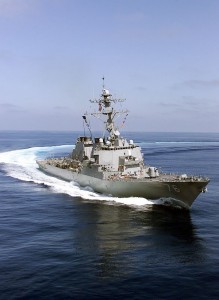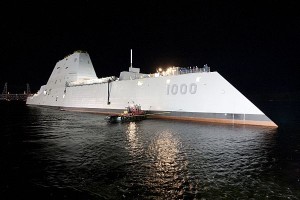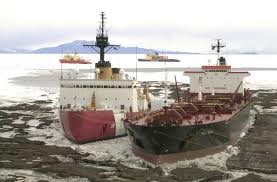 Poor Bath Ironworks. Over the past decade, Bath has endured one heck of a fall from grace–going from a favored ship-production site and world-renowned naval combatant manufacturer to, well, something of a demoralized mess.
Poor Bath Ironworks. Over the past decade, Bath has endured one heck of a fall from grace–going from a favored ship-production site and world-renowned naval combatant manufacturer to, well, something of a demoralized mess.
It’s serious. Wandering around the Navy Yard, I have never heard the Navy semi-publicly vent over a shipyard’s attitude and performance in a long, long long time (though DDG-115 seems to be doing OK in trials). Everybody’s steaming. Tempers are so high it’s almost a throwback to the epic Yard-Navy battles from the Cold War-era Ohio/Los Angeles Class or LHA/Spruance production runs. Things have gotten so ugly, it even has some smart people wondering if Bath is doomed or if General Dynamics Corporate will pull the plug and throw the yard to somebody else.
Those fears are overblown. Yes, Fred Harris’ combative leadership and maladroit maneuvers in DC failed to help, but, hell, shipbuilding isn’t a business for the faint-hearted and, frankly, it’d be the same no matter who was in charge.
It’s all a product of several missteps. General Dynamics (and Bath) bet big on the LCS, which was torn from them. Then they bet big on the DDG-1000–which was over-gilded to the point of irrelevance (let’s field a gun with million-dollar shells? ugh) and is in the process of yielding the mantel of “future big combatant” to an LPD-17 variant. They’ve been stuck with a short, three-ship production run there. Then they had to manage to the presumed end of the DDG-51 production line, only to have it restart, re-emerging in a far more complex “no-spare-margin” Flight III. FMS opportunities to certain countries dried up. And then they had to try and win the OPC–while the lobbying power of General Dynamics was totally and completely focused on the SSBN(X). At the time, these were good, solid choices–all done with solid General Dynamics business sense behind ’em. But…in business, sometimes the coin just flips bad. (And more bad news may come if the third DDG-1000 is cancelled and scrapped on the ways–a distinct possibility, given the problems with this tech-demonstrator platform.)
Meanwhile, Bath’s rival, Huntington Ingalls Industries’ Ingalls division, got out from under the Northrop Grumman conglomerate (which was struggling to figure out what to do with it’s shipbuilding companies anyway), and, under dedicated management, consolidated, powered through “starting line” issues with the NSC Cutter and LPD-17 production runs, and is now enjoying the happy times any shipyard experiences in the midst of a couple stable, sustained production runs.
No wonder things are a little rough for Bath. But this will pass. As I had the opportunity to tell Nathan Strout over at the Press Record last week:
“Bath is in a tough spot,” said Craig Hooper, who studies national security challenges at Gryphon Scientific and writes about Navy shipbuilding on his blog, Next Navy.
“Shipyards are never at their best when they are introducing a new ship or building the last ship of a production run,” added Hooper. “With the high-tech DDG-1000, Bath is doing both.”
I didn’t even mention fun that will be the jam-packed, no-margin and likely-to-be-delayed start of Flight III Burke production. The Flight III is going to be an ugly program.
 Naval Shipbuilding Is Cyclical
Naval Shipbuilding Is Cyclical
Basically, Bath is in a shipbuilding bind. And when a yard is on a bad shipbuilding streak, it’s really, really hard to break the cycle.
First, if the yard is in an attenuated production “run” with a complex ship, the yard has usually recapitalized to handle the expected production. Bath invested an enormous amount in the yard to win the DDG-1000 program. So the moment the DDG-1000 program got cancelled at only three ships, the yard’s margins collapsed and creditors (or folks from GD Corporate) likely jumped in to make everybody at Bath miserable.
Then, with a short, three-DDG-1000 production run, suddenly there’s not a lot of places to “hide” the over-run and slop that can usually be obscured in later follow-on ships in a larger production run. So, if there’s any “first-in-class” issues, the yard is pretty much naked. Admittedly, the Navy has done Bath a solid by pulling the first ship out of the yard to be completed later (if you think the DDG-1000 is a “full-up round” right now I’ve got a bridge to sell you), so Bath won’t get too ground up by systems integration issues. But still, outside of Navy’s machinations, there’s nowhere to hide poor labor estimates/performance issues/fiscal slips.
So as all this hits the bottom line, it impacts competitiveness. If a competitor like Ingalls is rocking through mid-production of a long multi-ship buy, performing and driving up their margin, then, well, Bath is going to be the second-place winner of far less favorable production terms for a long, long time. That’s the price of competition that the Navy grants their “docile duopolies”. The winner–if it can meet production targets–gets a chance at a goodly amount of profit, while the loser stays alive until the next bid cycle. In essence, second place sucks.
Bath is locked in a shipbuilding bind–right now they’ve got very little operational flexibility, and they’re gonna get bad contracts until something changes that makes Bath more competitive than Ingalls.
 How to Fix It:
How to Fix It:
Aside from a good, steady production run (maybe with some less-ambitious, ice-hardened littoral DDG-51s?) or some work-share with Electric Boat during the upcoming pulse of 2020-ish sub-building, I don’t see Bath getting well soon.
To survive, Bath needs complex Navy (or FMS) work. Union workforce or not, Bath is never going to have the margin to complete for commercial work. And there are too many hungry competitors and specialists for low-end Navy ships, so, as I say in the article,
“It would be a mistake for Bath to try and compete for tugs, auxiliaries or other simple, low-cost naval vessels,” added Hooper. “Many more yards compete for this work and can beat Bath on price.”
But they’ve gotta win something; with the collapse of the commercial fishing industry and the northeast’s shipbuilding industry overall, there’s just no work for Bath technicians outside of the yard. Unlike the Gulf, the commercial industrial base isn’t around to offer a labor “bank” for Bath–to deposit to or withdraw from as needed. Once Bath lays off a welder for lack of work, they’re effectively gone.
To overcome this, Maine (if the State even wants to keep it’s naval shipbuilding industry) has gotta get serious about building a training infrastructure. It’s an arrangement that, if, Bath needs to temporarily downsizes, a source of new trainees ensures Bath can grow quick–but there’s no indication that the State Government has any inclination to follow Connecticut and Rhode Island’s lead, adding training resources to help Electric Boat win a big multi-boat SSBN contract.
Second, there’s a sense that Bath is going to get anything and everything DDG-51-related. That’s not true. Ingalls builds ’em. They’ve shown they can out-hustle Bath. And, today, nothing is guaranteed–so Maine, the community of Bath, the Bath Ironworks’ Labor Unions and General Dynamics executives need to break from their complaisant attitudes. DDG-51 work is work the Bath community can lose, and this new government based on free-market principals could be perfectly happy to let Bath fail in order to move naval ship production south, to Philly or even Baltimore.
To survive, the Maine shipbuilding community needs to come together, figure out a plan, and push ahead. Do what Pensacola Florida did to win the Coast Guard’s OPC–push for a complex surface combatant (a new air defense cruiser, for example), or ice hardened combatants or even icebreakers.
Bath’s a good yard. But, in these days, no shipyard is irreplaceable.
